AI agents are rapidly emerging as a strategic focus in enterprise tech, driven by advances in large language models, tool use, and memory capabilities. OpenAI’s latest updates, along with a growing ecosystem of orchestration frameworks, have made it easier than ever to prototype intelligent agents. But most of what’s being built today remains limited in scope—task bots with narrow functions and minimal system integration.
As Forrester notes, the “AI co-worker” narrative is largely premature. Without access to enterprise systems, structured data, and secure execution environments, agents lack the context and capability to deliver real business value. To unlock their full potential, AI agents must be deeply embedded into enterprise workflows—securely, contextually, and at scale.
This is where Rierino offers a distinct advantage. Designed for composability and control, Rierino enables organizations to build empowered AI agents that go beyond surface-level interaction—agents that can access internal systems, trigger real-time workflows, and operate with the security and governance enterprises require.
In this article, we’ll explore:
- What makes an AI agent truly enterprise-ready—not just another chatbot
- The key trends driving next-generation AI agent development in 2025
- How to effectively connect large language models (LLMs) to internal systems
- The role of low-code and event-driven architecture in scaling AI automation
- How to build agents that execute real tasks and integrate seamlessly with your tech stack
The Rise (and Misconception) of Agentic AI
The concept of agentic AI has gained traction as organizations look to move beyond traditional automation and toward intelligent systems that can operate with a degree of autonomy. But despite the excitement, the term is often misunderstood—used to describe everything from simple chatbots to early-stage copilots.
In reality, most of today’s AI agents are limited to surface-level interaction. They can generate natural language responses or trigger predefined actions, but they typically lack the depth required to operate within real enterprise environments. They don’t have access to internal systems, can’t reason over structured business data, and aren’t designed with enterprise security or governance in mind.
To understand what agentic AI actually represents, it helps to look at how expectations have evolved. Initially, AI agents were built to respond—answering queries, surfacing documents, or performing narrow tasks. Then came the introduction of tool use and memory, enabling agents to interact with APIs and retain short-term context across sessions. This opened the door to more advanced use cases: chaining actions together, interacting with business systems, and executing multi-step processes. But even with these advancements, there’s a critical distinction to be made:
Agentic AI isn’t just about autonomy—it’s about embedding intelligence into enterprise context.
That means giving agents the ability to:
- Access and interpret structured business data (e.g., from ERP, CRM, HRMS)
- Operate inside secure, governed environments with role-based access
- React to real-time business events, not just user prompts
- Make decisions and take actions based on dynamic rules and conditions
In short, agentic AI delivers the maximum value when it's wired into the fabric of enterprise systems. Otherwise, it risks becoming just another siloed interface—impressive in a demo, but disconnected from the workflows that actually drive business outcomes. This is where many current solutions fall short. They treat agents as conversational overlays rather than core components of the enterprise architecture. They prioritize ease of use over depth of integration, and in doing so, limit the agent’s ability to perform real, high-value tasks.
To realize the full promise of agentic AI, organizations need platforms that provide not just language model access, but deep system-level integration, structured automation, and secure execution. That’s where Rierino comes in—providing the infrastructure to develop AI agents that are not only intelligent, but context-aware, composable, and ready for enterprise-scale deployment.
What Makes an AI Agent 'Empowered' in the Enterprise?
In any enterprise, employees don’t operate in a vacuum. Their ability to contribute meaningfully depends on a few critical enablers: access to the right data, well-defined responsibilities, secure tools, and the authority to act within structured workflows. Empowered employees are not just informed—they're equipped to make decisions, collaborate across functions, and take initiative within clear boundaries.
The same is true for AI agents. An AI agent can only go so far without visibility into business context or the means to execute real tasks. Like an employee without system access or decision rights, an agent without integration is limited to superficial interactions.
Empowerment, for AI agents, means being plugged into the operational core of the business—securely, intelligently, and in real time.
Here’s how that distinction plays out in practice:
- Standard vs CRM-Integrated Customer Support Agent: A generic chatbot may offer polite answers and links to help docs. But an empowered support agent, connected to your CRM, can instantly reference a customer's order history, track open tickets, and respond with personalized recommendations. It becomes a true extension of your service team—fast, accurate, and context-aware.
- Standard vs ERP-Integrated Procurement Agent: A basic procurement assistant might tell you what forms to fill out. An empowered one fetches live inventory data from the ERP, auto-generates a purchase request, and routes it for approval—all in one interaction. This isn’t just automation—it’s intelligent execution.
- Standard vs HRMS-Integrated HR Agent: Without access to internal systems, an HR chatbot is just a policy lookup tool. But connected to an HRMS, it can show leave balances, retrieve payslips, or even update employee records with built-in access controls. It reduces bottlenecks while staying compliant with internal protocols.
The core difference? Empowered agents are not just interfaces. They are operational entities.
To function at this level, they must have:
- Structured access to enterprise data: Not just unstructured documents or search results, but real-time, structured inputs from core systems like ERP, CRM, HRMS, or proprietary databases.
- Authorization-aware execution paths: Agents must understand and respect user roles, permissions, and workflow constraints—just like any enterprise-grade system component.
- Integration with dynamic business logic: Whether triggered by events, rules, or user input, empowered agents must align with how the business actually operates—not rely on hardcoded responses or brittle logic trees.
- Auditability and control: Enterprise agents should be observable and governable. Their actions need to be traceable and their access controllable, especially in regulated industries.
This level of enablement transforms AI agents from passive assistants into active contributors. They don’t just respond to inputs—they initiate outcomes. And when these capabilities are embedded securely within your infrastructure, they become trusted digital teammates. This is the foundation that Rierino provides—enabling AI agents to operate with the same confidence, control, and clarity you expect from your most effective human teams.
Trends Enabling the Next Phase of AI Agents
AI agents are entering a new phase—one defined not just by smarter language models, but by infrastructure that enables agents to act with context, autonomy, and control. In just the past few months, we’ve seen a clear shift from experimentation to operationalization.
Here are the most significant developments shaping that evolution:
- Tool Use Becoming Standard, Not Experimental: OpenAI and others now support persistent tool use, enabling agents to call APIs, trigger workflows, and complete tasks—not just generate responses. This capability is quickly becoming table stakes for any serious agent.
- Emerging Frameworks for Multi-Agent Collaboration: Open-source projects like LangGraph, CrewAI, and AutoGen are promoting agent architectures where multiple specialized agents coordinate and hand off tasks. This reflects how enterprises already structure teams and workflows.
- Hybrid and Local LLMs Going Mainstream: With increasing demand for data privacy, cost efficiency, and performance tuning, enterprises are combining cloud-based LLMs with local or private models—requiring flexible orchestration across multiple AI providers.
- Top Priority on Agent Security, Governance, and Observability: As agents begin to take real action, enterprises are prioritizing role-based access, auditability, and control. It's no longer enough for agents to be capable—they must also be compliant and trustworthy.
- Composable Architectures Replacing Black-Box Agents: Rather than relying on rigid, vendor-controlled copilots, organizations are shifting toward fully composable stacks. This enables deeper integration with internal systems, faster iteration, and long-term ownership.
Together, these trends signal a major shift: AI agents are no longer peripheral—they are becoming core components of enterprise architecture. But to fully capitalize on this shift, organizations need platforms that aren’t just compatible with these trends—they need platforms designed for them.
Rierino: The Platform Built for Enterprise-Grade AI Agents
Building real enterprise-grade agents now requires platforms that can operate at the intersection of AI, integration, and automation. This is where low-code platforms, when architected correctly, provide a powerful advantage. They allow teams to move quickly, experiment safely, and bring AI-powered automation into production without rebuilding foundational systems.
By abstracting complexity without losing control, low-code environments enable developers to focus on agent behavior, system logic, and business outcomes—rather than glue code or integration plumbing.
But to truly support the needs of enterprise AI agents, a low-code platform must go far beyond visual workflows or chatbot components. It must offer backend extensibility, secure data access, real-time orchestration, and composable agent logic that can evolve over time.
Rierino is designed around these enterprise requirements. It enables the configuration of AI agents that interact with internal systems, trigger real-time workflows, and operate under tightly governed access controls. Agents can interact with backend logic via saga flows, Rierino’s event-driven workflow components, which define how data is accessed, processed, and acted upon across services. Saga flows may encapsulate business processes such as inventory lookups, order processing, approval routing, external API orchestration, or triggering ML inference pipelines.

These flows are automatically exposed as structured tools that LLMs can invoke, enabling agents to perform business actions—not just generate content. All executions are governed by platform-level policies for authentication, authorization, schema validation, and audit logging.
Rierino supports integration with a broad range of LLM providers—cloud-based or on-prem—allowing teams to optimize for performance, cost, or compliance requirements. While flows are visually defined, developers retain full control over underlying logic and can extend functionality through code-level expressions, custom connectors, or service integrations where necessary. The result is a system where AI agents can be built once and reused across multiple contexts, with logic that remains modular, observable, and adaptable.
| AI Agent Dev Capability | Rierino | Typical Low-Code Platforms |
|---|---|---|
| Model support | ✅ Native, multi-provider integration | ⚠️ Limited or vendor-specific |
| Workflow engine | ✅ Event-driven saga flows | ❌ UI-centric, trigger-based |
| Security & governance | ✅ RBAC, validation, audit logging | ⚠️ External or inconsistent setup |
| LLM tool mapping | ✅ Flows exposed as structured tools | ❌ Manual or unavailable |
| Extensibility | ✅ Modular, black-box-free logic | ⚠️ Vendor-constrained components |
| Access channels | ✅ UI, API, event-driven triggers | ⚠️ Fragmented or duplicated logic |
What Sets Rierino Apart
- Multi-Model Compatibility with Full Control: Supports OpenAI, Bedrock, Gemini, Mistral, Anthropic, and on-prem models—allowing AI workloads to be dynamically routed or segmented based on business policy or data sensitivity.
- Saga Flows as Native Tools for Agents: Every saga flow can be accessed by AI agents as a callable tool, with predefined inputs, outputs, and security rules—no manual mapping or wrappers required.
- Security, Authorization, and Compliance by Design: Authentication, role-based access, data validation, and auditing are built into the runtime—ensuring agents remain within defined governance boundaries without additional infrastructure.
- Composable, Microservice-Based Architecture: Workflows and agent logic are modular and versionable. Teams can update, extend, or reconfigure agents without redeploying core services or duplicating logic.
- Unified Deployment and Accessibility: Agents can be accessed through the Rierino UI, external APIs, or triggered by events—supporting both real-time interactions and background automations.
Use Case: Building a Procurement Agent on Rierino
To demonstrate how Rierino supports empowered AI agents in practice, let’s walk through the creation of an AI-powered Procurement Agent. This agent is designed to assist with and automate key procurement operations by interacting directly with internal ERP systems and triggering pre-configured workflows.
The goal: Enable the agent to retrieve product data, create purchase requests (PRs), and notify stakeholders—all within enterprise constraints and without manual intervention.
Step 1: Define Business Logic Using Saga Flows
Rierino’s saga flows allow developers to visually or programmatically define workflows for backend tasks. In this case, we create a saga that retrieves product availability data from the ERP, evaluates eligible vendors based on delivery time, pricing, and vendor rating, selects the optimal vendor dynamically, composes a PR request, and executes validation and approval routing based on predefined business logic.
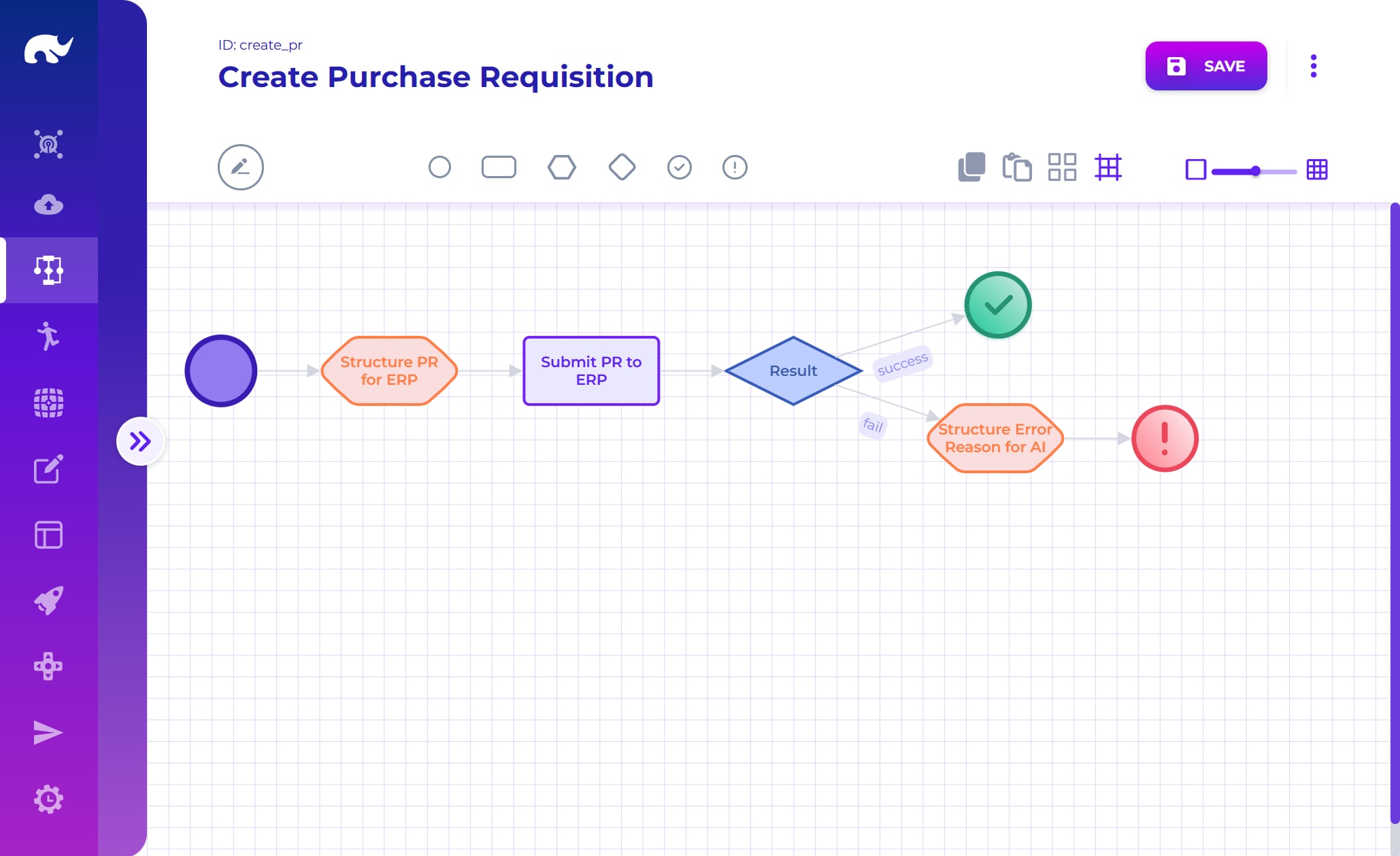
This vendor evaluation logic is defined using structured data inputs, configurable scoring rules, and internal metrics available in the ERP or vendor database. The agent doesn't just passively request a PR—it actively selects the best-fit vendor based on business priorities.
Once the saga is built and authorized, it becomes reusable across multiple agents or interfaces.
Step 2: Expose Saga Flow as a Tool for the AI Agent
Rierino automatically maps the saga flow as a structured tool that LLMs can invoke. The platform handles the conversion of flow input/output parameters into a schema that the LLM understands, along with built-in validation and access control.
No custom mapping logic is required. The Procurement Agent can now call this saga flow as part of its toolset during interactions.
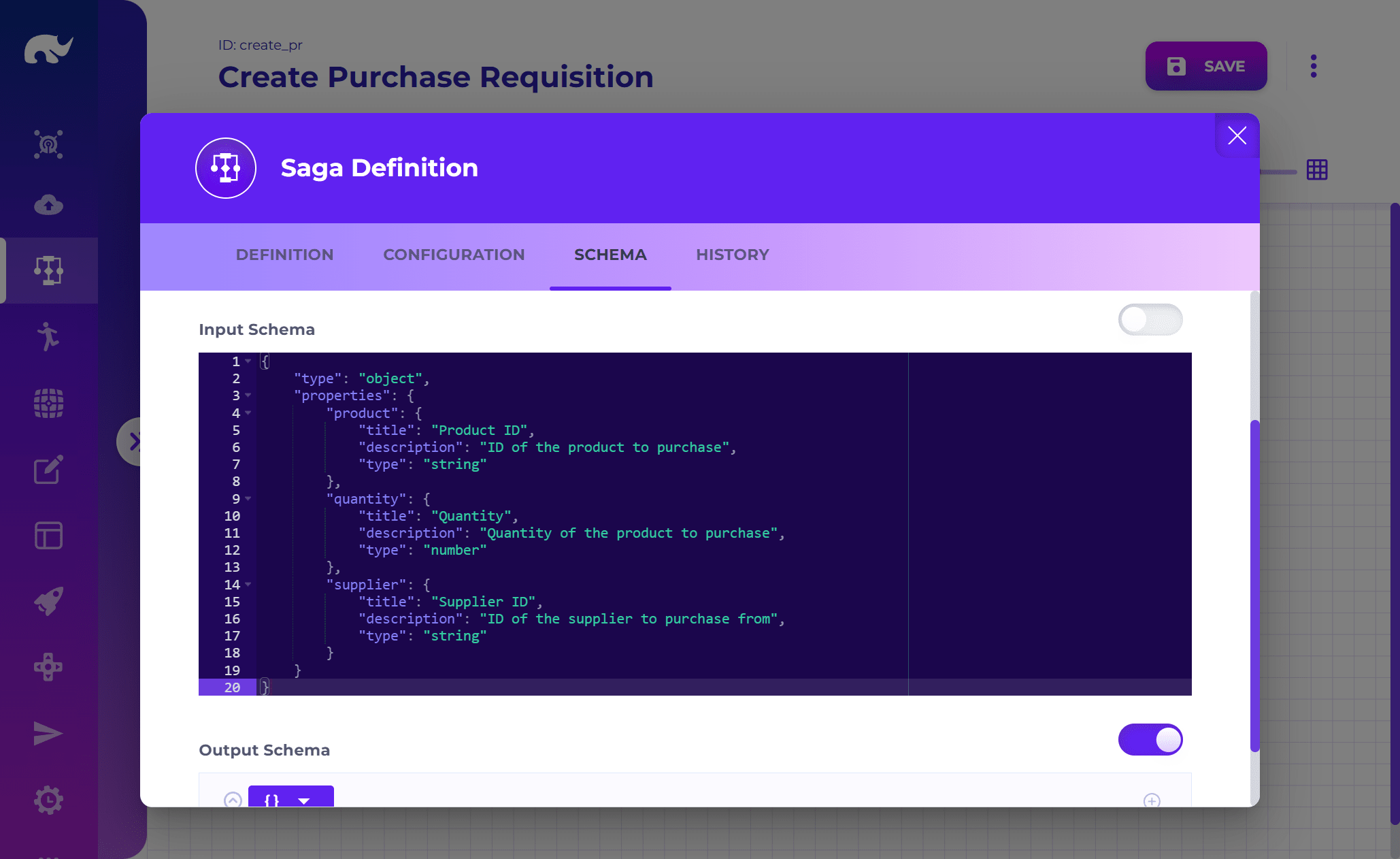
Step 3: Configure the AI Agent
Next, the agent is configured in the Rierino Admin UI. Here, developers select the associated language model, assign accessible tools (in this case, the PR flow), and define any model specific parameters such as memory size, max retries and temperature.
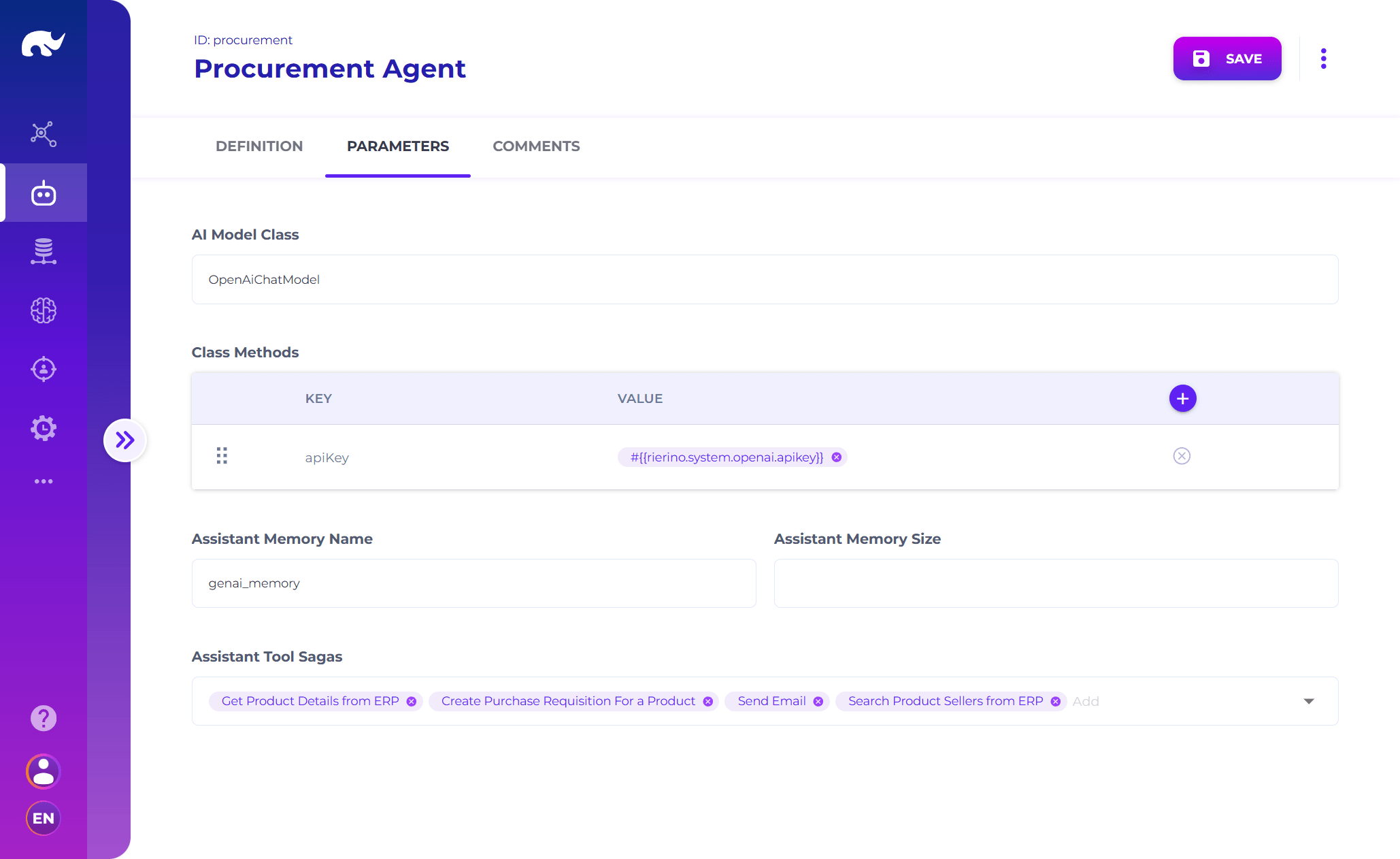
The agent is now ready to operate within the platform, with full security and observability in place.
Step 4: Interact with the Agent via UI or External Interface
The Procurement Agent is accessible immediately via the admin interface for internal users. It can also be exposed externally via APIs or triggered by backend events—for example, when a stock threshold is reached or a recurring procurement cycle is due.
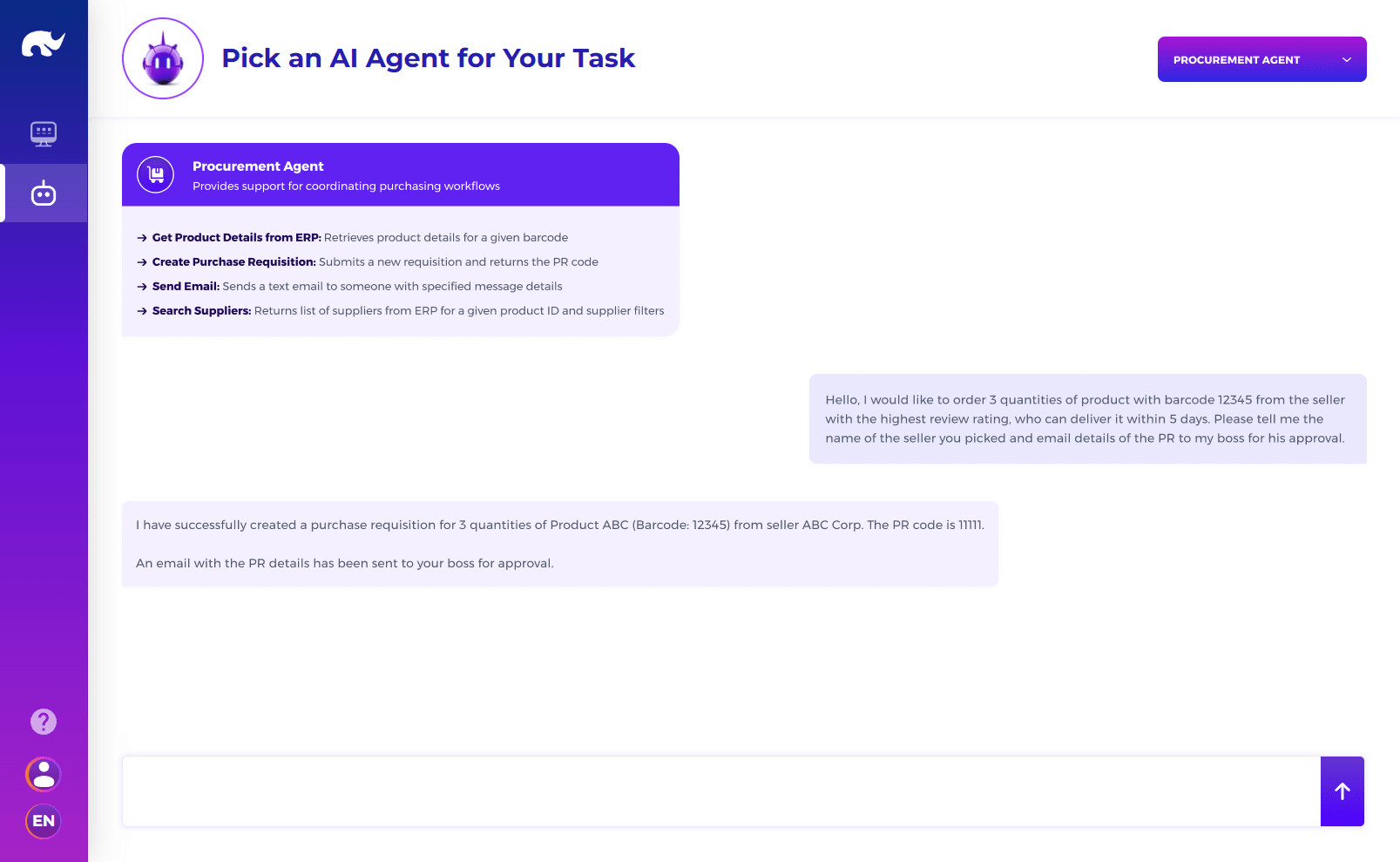
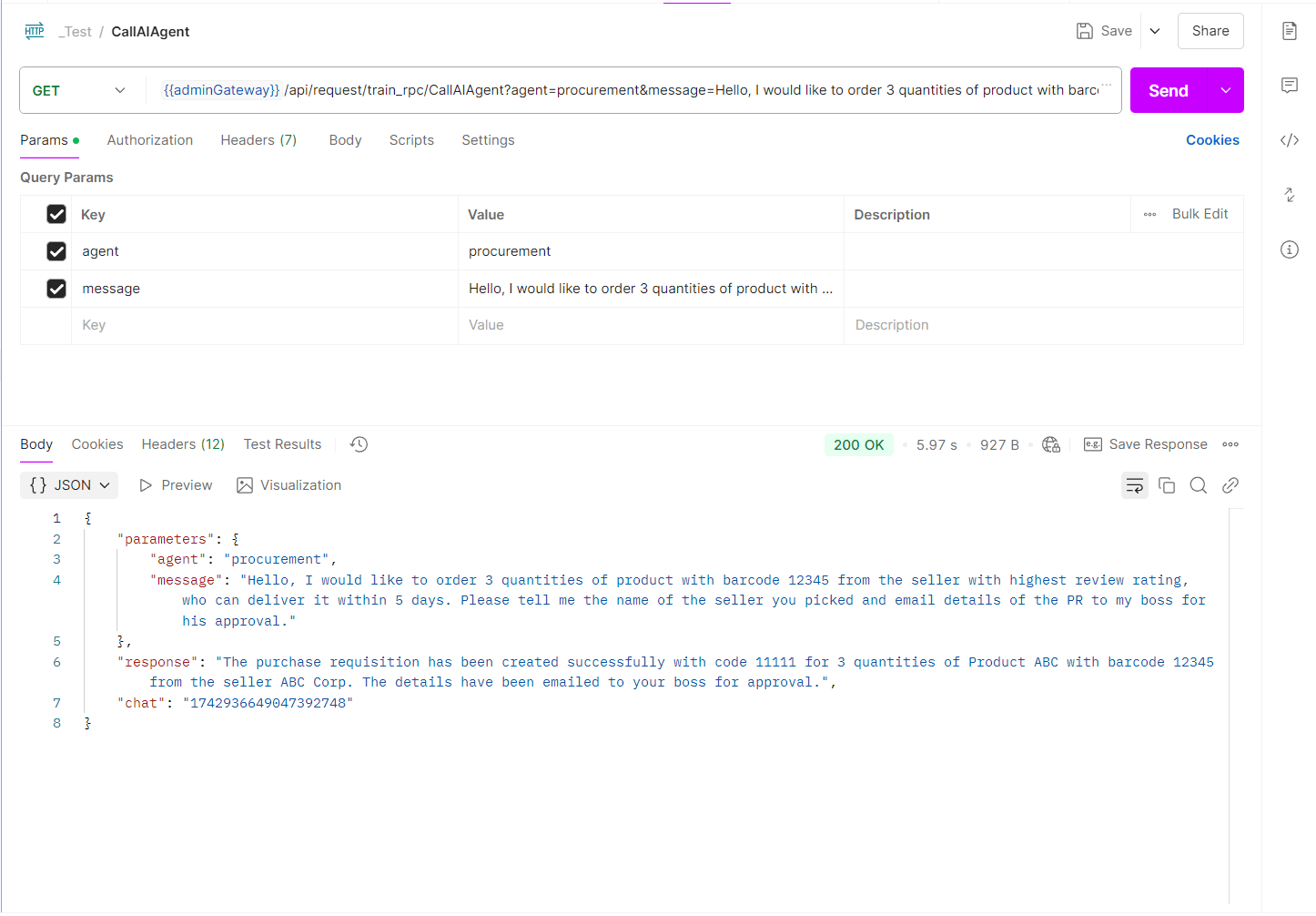
This example demonstrates several key strengths of the Rierino platform:
- The agent isn’t hardcoded. It uses reusable saga flows that can be adapted or extended without altering the agent itself.
- No middleware is needed. Once the saga flow is created, it’s natively callable by the LLM—Rierino handles the interface translation and governance.
- Security is consistent. Access, validation, and audit are enforced at the platform level, not in isolated services or scripts.
- It’s deployable anywhere. Whether surfaced via UI, API, or background trigger, the agent logic is reusable and scalable by design.
This kind of AI agent isn’t just answering questions—it’s executing tasks, following business rules, and operating securely inside enterprise systems.
From Agent Hype to Enterprise Value
AI agents are quickly becoming an essential part of enterprise transformation—but real impact depends on how effectively they’re embedded into systems, workflows, and decision-making processes. Moving from experimental bots to production-grade agents requires infrastructure that can support integration, orchestration, and control from the start.
That’s where platform design matters. Low-code platforms—when purpose-built for backend extensibility and secure automation—can dramatically accelerate AI agent development. They give development teams the ability to move fast while keeping agents grounded in real business logic and governance frameworks.
With event-driven saga flows, multi-model LLM integration, structured tool mapping, and secure runtime controls, Rierino enables developers to build and deploy intelligent agents that are not only fast to develop—but ready to scale. Whether the goal is streamlining procurement, improving support operations, or powering internal automation, Rierino gives teams the tools to go beyond conversation and into coordinated, intelligent execution. It’s AI agent development at the speed of innovation—without the trade-offs.
Ready to accelerate your AI agent development? Get in touch with our experts today to discover how Rierino can help you build intelligent solutions tailored to your business needs.
RELATED RESOURCES
Check out more of our related insights and news.
FAQs
Your top questions, answered. Need more details?
Our team is always here to help.



